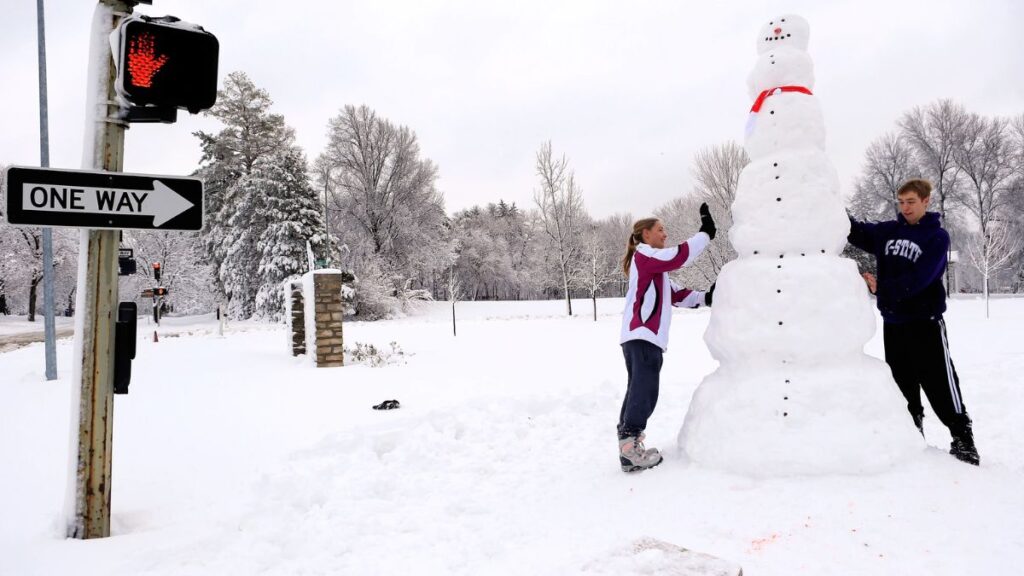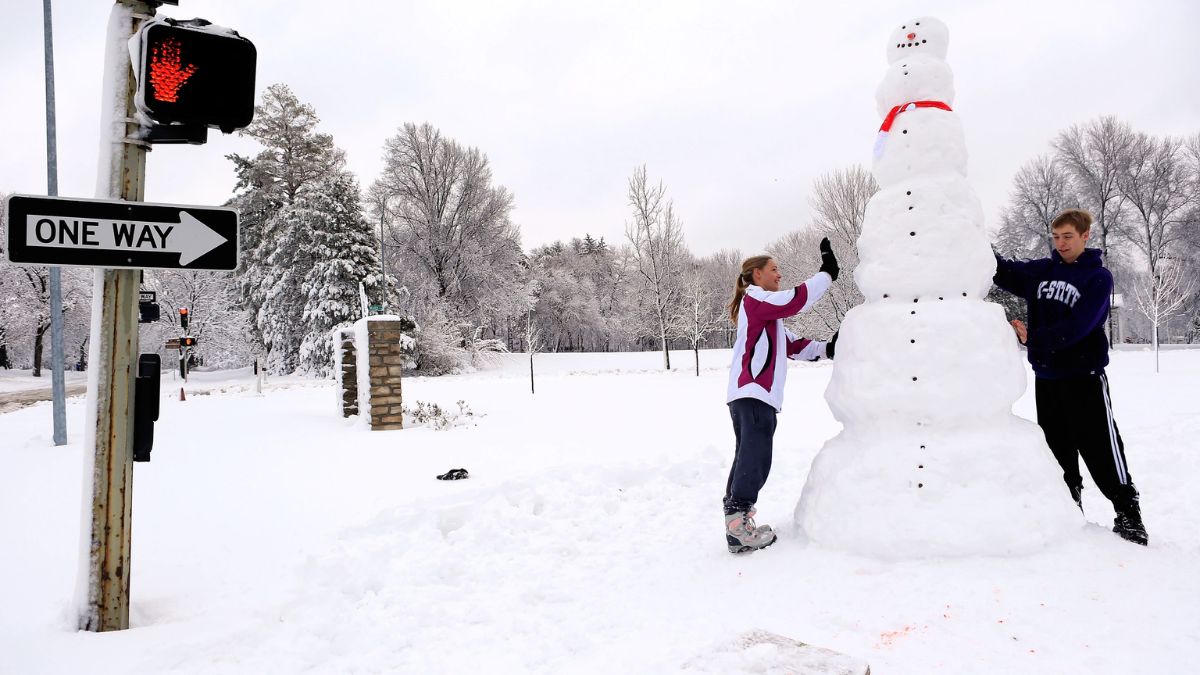Yes, it does snow in Kansas. While Kansas is not known for its heavy snowfall or long-lasting winter conditions like some northern states, snow does fall in the state in winter. The amount of snow can vary significantly from year to year and from region to region within Kansas.
Various weather systems, including Arctic air masses, Alberta clippers, and occasional winter storms, influence the snowfall patterns in Kansas. Overall, while snowfall in Kansas may not be as common or extensive as in some other regions, residents and visitors can still experience snowy conditions in winter.
Kansas is often referred to as the Sunflower State. It is known for its vast prairies, sweeping wheat fields, and hot summers. However, when it comes to winter weather, many people wonder if this Midwestern state experiences snowfall.

In this article, we delve into the winter climate of Kansas to answer the question, “Does it snow in Kansas?”
Location Overview
Kansas is a state located in the central part of the United States. It is bordered by Nebraska to the north, Missouri to the east, Oklahoma to the south, and Colorado to the west. The state covers an area of approximately 82,278 square miles and is divided into 105 counties.
Kansas is situated away from any major bodies of water, contributing to its continental climate. The state experiences hot summers and cold winters, with significant temperature variations throughout the year.
The state’s capital and largest city is Topeka, located in the northeastern part of Kansas. Other major cities include Wichita, Overland Park, Kansas City, and Lawrence. Kansas is known for its friendly and welcoming communities, and its residents, often referred to as Kansans, take pride in their agricultural heritage.
Kansas has a diverse economy, with agriculture being a significant sector. The state is one of the leading producers of wheat, corn, sorghum, and soybeans in the United States. Additionally, Kansas has a growing aerospace industry, with major aircraft manufacturing and aviation companies located in the state.
In terms of attractions, Kansas offers a range of cultural, historical, and natural sites. It is home to several renowned museums, including the Museum of World Treasures in Wichita and the Kansas Museum of History in Topeka.
Geography and Climate of Kansas
The geography of Kansas is primarily characterized by flat plains, rolling hills, and a few river valleys. The state’s position in the central part of the country influences its weather patterns and winter climate.
It is often referred to as the “Sunflower State” due to its abundance of sunflowers, which thrive in its sunny climate. The state also features the iconic Flint Hills, a region known for its tallgrass prairies and scenic beauty.
Kansas has a continental climate, which means it experiences hot summers and cold winters. The state is situated far away from any large bodies of water, which reduces the moderating influence of water on its climate. As a result, Kansas is subject to significant temperature variations throughout the year, including winter.
Historical Snowfall Record
Kansas has a varied and unpredictable snowfall pattern, with significant variations from year to year. While the state does experience snowfall in winter, it is important to note that historical records may vary depending on the specific location within Kansas.
Here are some examples of historical snowfall records in different cities across the state:
- Wichita
The largest city in Kansas has seen a range of snowfall amounts over the years. The record snowfall for Wichita occurred on February 2, 1900, when the city received a whopping 15 inches of snow in a single day.
- Topeka
The capital city of Kansas has also witnessed notable snowfall events. The highest recorded snowfall in Topeka happened on February 21, 2013, with 14.2 inches falling in a 24-hour period.
- Dodge City
Located in western Kansas, Dodge City has experienced its fair share of snowstorms. The highest snowfall on record for Dodge City occurred on February 6, 1903, when the city received 24 inches of snow in one day.
- Goodland
As a city in the northwest corner of Kansas, Goodland often receives more snowfall than other areas. On March 28, 1970, Goodland recorded its highest snowfall, with a total of 26.6 inches falling during a storm.
It is worth noting that these are just a few examples of significant snowfall events in Kansas’ history. Snowfall amounts can vary widely from year to year and between different regions within the state.
Winter Season & Snowfall Pattern
- Winter Temperature Range
During the winter season, Kansas typically experiences chilly temperatures. The average low temperatures in January, the coldest month, range from the mid-teens Fahrenheit in the northwest to the low 20s Fahrenheit in the southeast.
High temperatures during this time range from the mid-30s Fahrenheit in the northwest to the low 40s Fahrenheit in the southeast.
- Snowfall in Kansas
The state experiences snowfall during the winter months, although the snow can vary significantly from year to year and region. The areas in the northwestern part of the state generally receive more snowfall than the southeastern areas.
- Snowfall Patterns
Various weather systems, including Arctic air masses, Alberta clippers, and the occasional winter storm, influence Kansas’ snowfall patterns. The western and northwestern parts of the state tend to receive more snow due to orographic lifting, where moist air rises and cools, leading to precipitation.
- Snowfall Averages
The average annual snowfall in Kansas varies across the state. The northwestern part of Kansas receives the highest average snowfall, ranging from around 20 to 40 inches per year. In contrast, the state’s southeastern part typically receives around 10 inches or less of snow annually.
Locations to Enjoy Snow
While snowfall in Kansas may not be as abundant or consistent compared to other regions, there are still several locations where you can enjoy the snow and partake in winter activities. Here are a few places in Kansas where you can embrace the snowy season:
- Smoky Hill River Valley
Located in central Kansas, the Smoky Hill River Valley offers picturesque landscapes during the winter months. With rolling hills and scenic trails, it provides a serene setting for winter hikes, cross-country skiing, or snowshoeing.
- Flint Hills
The Flint Hills region, known for its tallgrass prairies, transforms into a winter wonderland when covered in snow. The vast open spaces and undulating terrain create a beautiful backdrop for winter photography and peaceful walks.
- Tuttle Creek State Park
Situated near Manhattan, Kansas, Tuttle Creek State Park offers opportunities for outdoor winter activities. The park features hiking trails, fishing spots, and camping areas. When snow blankets the landscape, you can enjoy snowshoeing through the park’s picturesque surroundings.
- Prairie Spirit Trail
This converted rail-trail stretches over 50 miles across eastern Kansas, passing through quaint towns and countryside. During winter, the trail is ideal for winter hiking or fat biking, where wide tires provide better traction in snowy conditions.
- Lake Scott State Park
Located in the western part of the state, Lake Scott State Park offers a mix of natural beauty and recreational activities. In winter, you can explore the park’s trails on snowshoes, go ice fishing on the frozen lake, or even try ice skating if conditions permit.
- Cedar Bluff State Park
Situated near Hays, Kansas, Cedar Bluff State Park is another great destination for winter adventures. The park features a reservoir surrounded by rugged terrain. During winter, visitors can go ice fishing, enjoy winter birdwatching, or even try snowmobiling in designated areas.
Embrace the winter beauty of Kansas and make the most of the snowy opportunities available in the state.
Factors Influencing Snowfall
Factors influencing snowfall in Kansas include its inland geographic location, weather systems such as Arctic air masses and winter storms, elevation, storm tracks, and cold temperatures. These factors collectively determine the frequency and amount of snowfall experienced in the state during winter.
Conclusion
While Kansas may not be renowned for its heavy snowfall or long-lasting winter conditions, snow does fall in the state during the winter months. Whether you are fascinated by winter sports or simply enjoy the serene beauty of snow-covered landscapes, Kansas has something to offer in winter.
